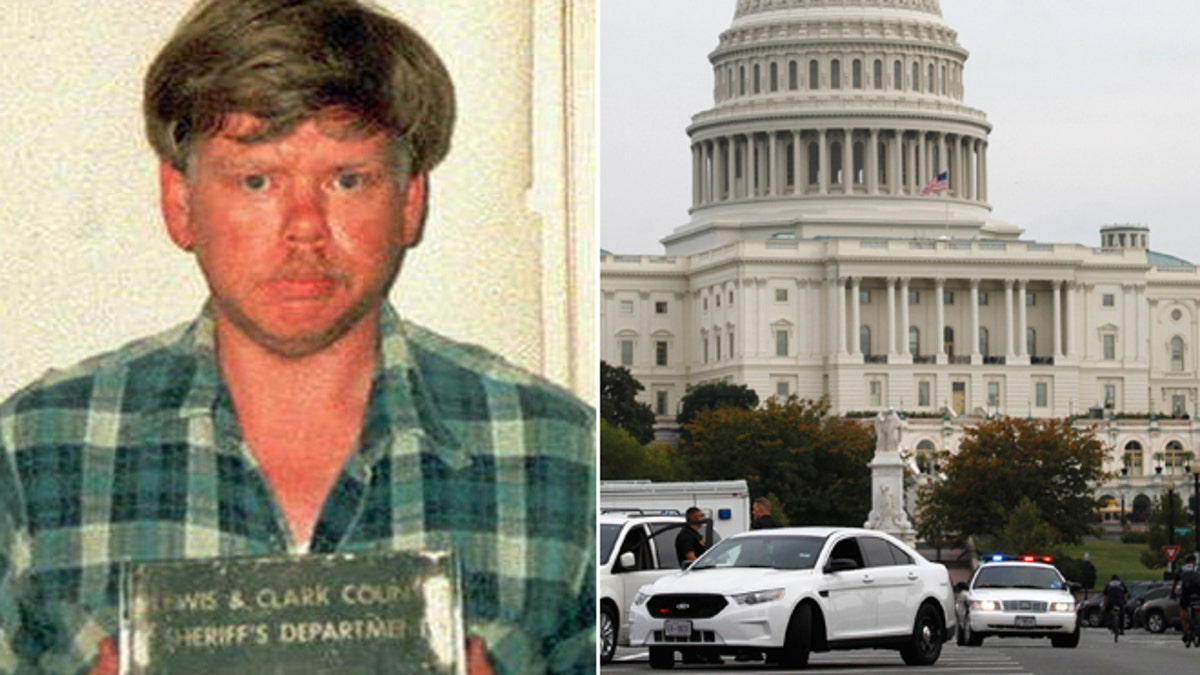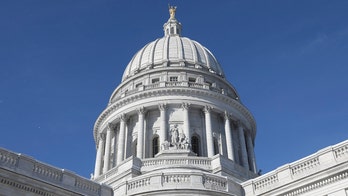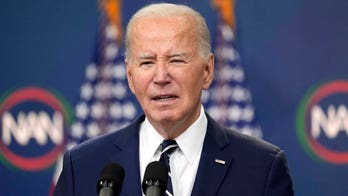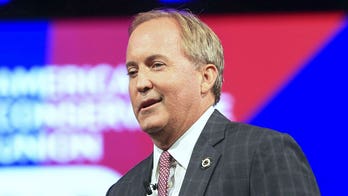
Booking photo from Montana of Russell Eugene Weston, Jr. and the U.S. Capitol on Capitol Hill in Washington. (AP/Reuters)
It’s stunning what someone with a gun -- regardless of motive or intention -- can do to the fortified, protected seats of sophisticated, western democracies.
Whether it be Parliament Hill in Ottawa. Or Capitol Hill in Washington.
And the heroism to combat such attacks is remarkable, too.
Washington’s dealt with this sort of thing, before.
Long before someone shot and killed a soldier at Canada’s National War Memorial and a masked gunman rushed into the Canadian Parliament down the street, there was Russell Weston Jr.
On July 24, 1998, Weston walked to the United States Capitol, armed with a .38 caliber Smith & Wesson revolver.
Like Parliament Hill in Ottawa, the East front of the U.S. Capitol features a great outdoor expanse – the length of least two football fields – stretching to the Supreme Court and Library of Congress across the street. There is a plaza. And two big grassy areas. People mingle. Tourists relax. Tired, overheated toddlers bawl. On nice days, some people recline under the shade of trees snacking on apples and sandwiches. Maybe bury themselves in a book. An artist or two shows up with an easel once in a while and paints.
Russell Weston Jr. had no interest in tourism, lunch or art when he showed up at the Capitol around 3:40 p.m. more than 16 years ago. A paranoid schizophrenic, Weston was on a mission.
Weston lived in a cabin in rural Rimini, Mont. The townspeople found him weird and kept their distance. Weston RSVP'd to a request to attend his high school reunion back in Illinois by scrawling line after line of obscenities on the postcard. He thought satellite dishes dotting the Montana landscape were there to spy on him and believed Navy SEALs maintained surveillance on him from a nearby field. Weston went back home to Illinois and compulsively chopped down trees. Just a few days before his visit to the Capitol, Weston shot 14 cats at his grandmother’s residence.
Doctors later said that Weston fretted he would soon succumb to “Black Heva,” and needed to warn U.S. officials about cannibals. Weston had a plan. He had assembled a special “Ruby Satellite System.” It could control time. Weston believed he could roll back time and save the nation if he could get into the Capitol. The government was falling to a conspiracy administered by President Clinton. After all, the president intended to nuke his Montana cabin.
Weston wanted to save the nation. But darn it, the consoles to control the Ruby Satellite System were locked in a Senate safe. So he had to get into the Capitol and get to those control panels. Nothing was going to stop him. There was no time to spare.
Weston had tried to help the government before. Two years earlier, he drove to CIA headquarters in suburban Virginia to try to sell America’s top spooks on the satellite array.
Weston brushed past U.S. Capitol Police officer Jacob Chestnut who was guarding what was then called the “Document Door” of the Capitol. Chestnut briefly stopped Weston and asked him to walk through the metal detector. He pointed the .38 at Chestnut’s head and fired, killing the officer instantly.
Just around the corner from the Document Door was the back entrance to the office of then-House Majority Whip Tom DeLay, R-Texas. As a member of the congressional leadership, the U.S. Capitol Police assigned a plainclothes detail to DeLay.
Detective John Gibson of DeLay’s detail heard the ruckus. Weston headed toward the backdoor to DeLay’s suite. Weston fired on Gibson multiple times, wounding him in the leg. Before Gibson died, he managed to get off a shot which in turn wounded Weston, halting the gunplay in the marble corridors of the U.S. Capitol.
Sen. Bill First, R-Tenn., a renowned heart surgeon who later became Senate majority leader, ran over to the scene. Gibson was gone. But Frist was able to save the life of Weston.
Weston recovered from his injuries but was ruled incompetent to stand trial. He later told doctors that Black Heva was the “most deadliest disease known to mankind.” Weston said he shot Chestnut and Gibson because they tried to keep him from the Ruby Satellite System. He said that President Clinton was a “Russian clone” and was leading an insurgency.
U.S. Capitol Police locked down the Capitol and evacuated the complex. Chaos reigned as tourists scampered across the usually bucolic lawn and plaza trying to escape the pandemonium. In the first few hours, no one knew if this was a lone gunman. No one knew if this was a terrorist attack. How many people were dead? Was it a massacre? Were lawmakers shot? Someone noted this might have something to do with the last time there was major gunfire inside the U.S. Capitol. Puerto Rican nationalists shot up the U.S. House chamber on March 1, 1954, wounding five lawmakers. The day Weston arrived was July 24. July 25 is Puerto Rican Constitution Day. Previously it was known as “Occupation Day” because U.S. forces arrived in Puerto Rico on that day in 1898.
But this had nothing to do with Puerto Rico. It had nothing to do with American politics, lawmakers' policies, viewpoints or legislation. It had to do with cannibalism and the Ruby Satellite System.
And a mentally-ill, deranged man with a handgun.
Tony Rudy, was general counsel to DeLay in 1998. In a few years, he’d do jail time after getting involved with corrupt super-lobbyist Jack Abramoff. But Rudy was crystal clear about the heroism of Gibson and Chestnut that day.
“The whole office believes that Gibson saved our lives,” Rudy said. “There’s no doubt in our mind that this guy would have run in and just shot people one at a time.”
In Ottawa, authorities say gunman Michael Zehaf-Bibeau stormed the Centre Block at the Canadian parliament.
House of Commons Sergeant-at-Arms Kevin Vickers was on duty Wednesday after decades as a member of the Royal Canadian Mounted Police (RCMP) in New Brunswick. Vickers' role is to provide security in the House of Commons. He was often in charge of protecting dignitaries and members of the Royal Family when they visited.
On Wednesday, as acrid gunpowder wafted though the Hall of Honour in Canada’s seat of government, Vickers -- like Gibson -- shot and killed Zehaf-Bibeau. As Rudy suggested in 1998 of Gibson, it’s likely Vickers saved the lives of others in the most-sacred corridors of Canadian power.
“Thank God for Sgt at Arms Kevin Vickers,” tweeted Canadian Justice Minister Peter MacKay.
Bedlam and confusion consumed Parliament Hill on Wednesday. Just like it did Capitol Hill on a sultry, July day in 1998.
But a common denominator sliced through both maelstroms. Heroism. Heroism in the persons of Jacob Chestnut and John Gibson in Washington.
And Kevin Vickers in Ottawa.
Capitol Attitude is a weekly column written by members of the Fox News Capitol Hill team. Their articles take you inside the halls of Congress, and cover the spectrum of policy issues being introduced, debated and voted on there.




